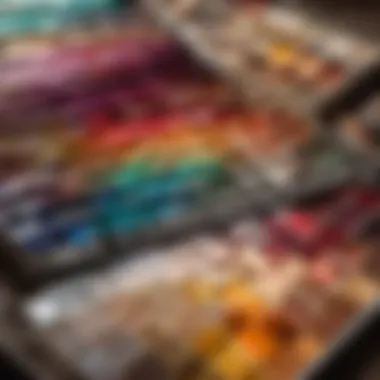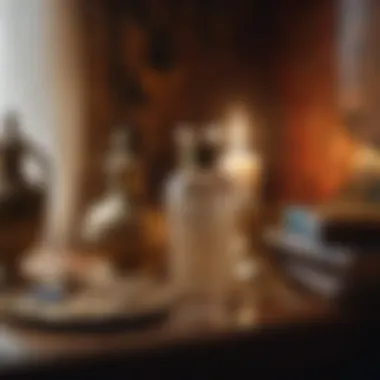Materials:
- Measuring tape (to accurately measure dimensions of closet space)
- Storage bins and boxes (for organization purposes)
- Hangers (to hang clothing items)
- Labels and a marker (to categorize and identify items)
- Cleaning supplies (to prepare the closet for organization)
DIY Steps:
- Begin by emptying the closet completely to assess the available space and determine the inventory of items to be organized.
- Measure the dimensions of the closet, including height, width, and depth, to plan the layout effectively.
- Sort through clothing items and accessories to declutter and discard or donate items that are no longer worn or needed.
- Utilize storage bins, boxes, and hangers to categorize and organize items based on type or season.
- Label each storage container or section within the closet to facilitate easy access and maintain organization.
- Clean the closet space thoroughly, including wiping down shelves, vacuuming carpets, and removing any dust or debris.
Technical Aspects:
- Tools: Measuring tape, labels, marker, cleaning cloths, vacuum cleaner
- Timing: Organizing a standard-sized closet may take several hours, depending on the extent of decluttering required
- Techniques: Utilize vertical space with hanging organizers, use transparent bins for easy visibility of contents, implement a color-coded system for further organization
DIY Project Process:
- Start by measuring the height of the closet to determine the placement of shelves and hanging rods.
- Place frequently used items at eye level for easy access, while seasonal or occasional items can be stored on higher or lower shelves.
- Utilize underutilized spaces, such as the back of the closet door, for additional storage using hooks or over-the-door organizers.
Troubleshooting Tips:
- If the closet space feels cramped, consider utilizing slimline hangers to maximize space efficiency.
- For small closets, employ cascading hangers or shelf dividers to create more storage options.
Enjoy the transformed and organized closet space, reflecting your personal style and showcasing your unique identity!
Introduction
Closets hold more than just clothes; they serve as a reflection of one's identity and personal style. The way we organize our closets goes beyond mere storage – it speaks volumes about our psychology and historical influences on wardrobe choices. In this article, we embark on a journey through the intimate realm of closets, uncovering the nuanced dynamics that shape our dressing rituals and sartorial preferences.
The Closet as a Reflection of Self
The Psychology Behind Closet Organization
When we meticulously arrange our clothing, we are engaging in a subconscious process of self-definition and control. The psychology behind closet organization delves into how our choices in sorting and tidying our garments mirror our inner thoughts and emotions. By understanding this aspect, we gain insight into the underlying motivations that drive our organizational behavior in our personal sanctuaries. This analysis sheds light on the intricate relationship between our external environment and internal psyche, making it a pivotal element in dissecting the essence of personal style within the confines of a closet.
Historical Perspectives on Wardrobe Choices
Delving into the historical context of wardrobe choices unveils a tapestry of cultural heritage and societal influences that have shaped fashion decisions over the centuries. From the carefully curated wardrobes of aristocrats to the practical attire of commoners, each garment tells a story of its era. Recognizing these historical perspectives enriches our understanding of why we dress the way we do today. By tracing the evolution of wardrobe choices, we acknowledge the continuum of sartorial expression and its enduring impact on contemporary style narratives.
Personal Style Evolution
Influences on Style Development
Our style evolution is a product of myriad influences, ranging from societal norms to personal experiences. Exploring the influences on style development delves into the intricate interplay between culture, media, and individual preferences. By dissecting these influences, we unravel the threads that weave together to create our unique sartorial identity. Understanding the factors that shape our style journey enables us to appreciate the complexities of fashion as a form of self-expression.
Adapting Style to Different Life Phases
As we transition through various life phases, our style adapts to reflect our evolving selves. Adapting style to different life phases involves a continuous process of renewal and reinvention. Whether it is adapting to new professional roles or embracing parenthood, our clothing choices mirror our growth and transformation. By acknowledging the need for stylistic adaptation, we embrace the fluidity of personal style and celebrate the multifaceted nature of our identities.
Emotional Attachment to Clothing
Sentimental Value of Certain Garments
Clothing holds the power to evoke memories and emotions, making certain garments cherished keepsakes in our closets. Understanding the sentimental value of certain garments unveils the emotional narratives woven into the very fabric of our attire. These items serve as tangible reminders of significant milestones, relationships, or moments in our lives. By appreciating the sentimental value of select pieces, we acknowledge the emotive power of clothing in capturing our personal histories.
Psychological Comfort in Familiar Clothes
The comfort derived from familiar clothes transcends mere physical sensations; it offers a sense of security and assurance in the midst of uncertainty. Psychological comfort in familiar clothes explores the psychological dimensions of clothing as sources of solace and familiarity. These pieces become extensions of our identity, providing a sanctuary of comfort in an ever-changing world. By delving into the psychological comfort of familiar garments, we unravel the intricacies of our emotional attachments and sartorial rituals.
The Walk-In Closet Experience


In this article, The Walk-In Closet Experience serves as a crucial component in exploring the intricacies of personal style and self-expression. The walk-in closet is more than just a storage space for clothes; it is a reflection of one's personality, organization skills, and lifestyle choices. Organizational Strategies and Techniques play a significant role in maximizing the functionality and aesthetic appeal of a walk-in closet. Effective organization not only streamlines the process of selecting outfits but also contributes to a sense of calm and order within the space.
Organizational Strategies and Techniques
Color Coding and Clothing Categories
Color Coding and Clothing Categories are essential elements of creating a well-organized and visually appealing walk-in closet. By categorizing clothing items based on color or type, individuals can easily locate specific pieces and create cohesive outfit combinations. The key characteristic of Color Coding and Clothing Categories is their ability to streamline the process of selecting outfits, saving time during busy mornings or special occasions. This method is popular among fashion enthusiasts and those with a keen eye for aesthetics due to its visually pleasing and practical nature. The unique feature of Color Coding is its potential to add a touch of sophistication to a closet while promoting organization and efficiency.
Utilizing Storage Solutions Effectively
Effective utilization of storage solutions is paramount to optimizing space and maintaining a clutter-free closet environment. Proper storage solutions, such as adjustable shelves, hanging organizers, and drawer dividers, can enhance accessibility and preserve the longevity of clothing items. The key characteristic of Utilizing Storage Solutions Effectively is its ability to create a tailored storage system that meets the specific needs and preferences of the individual. This choice is beneficial for individuals looking to maximize their closet space and prevent items from getting lost or damaged. The unique feature of Utilizing Storage Solutions Effectively lies in its capacity to transform a chaotic closet into a streamlined and visually appealing space.
Closet Minimalism vs. Maximalism
Pros and Cons of Simplified Wardrobes
The debate between Closet Minimalism and Maximalism revolves around the merits of owning fewer versus more clothing items. Simplified wardrobes offer benefits such as ease of decision-making, reduced clutter, and a focus on quality over quantity. However, drawbacks may include limited outfit options and the potential for monotony. The key characteristic of a Simplified Wardrobe is its emphasis on essential pieces that form the foundation of a versatile wardrobe, promoting mindful consumption and sustainable fashion practices. This choice is popular among minimalists and those seeking a curated wardrobe that reflects their personal style.
The Art of Curating a Diverse Collection
Curating a Diverse Collection involves selecting a wide range of clothing items that cater to various occasions, seasons, and style preferences. This approach allows individuals to express their creativity and adapt their style to different environments or moods. The key characteristic of curating a Diverse Collection is its ability to offer versatility and versatility, ensuring that individuals have options for any event or setting. This choice is beneficial for individuals who enjoy experimenting with different looks and embracing fashion as a form of self-expression.
Closet Inventory Analysis


Identifying Wardrobe Gaps and Redundancies
Identifying Wardrobe Gaps and Redundancies is essential for maintaining a functional and well-rounded wardrobe. By recognizing missing essentials or excessive duplicates, individuals can make informed decisions when expanding or refining their clothing collection. The key characteristic of this analysis is its capacity to prevent unnecessary purchases and ensure that each clothing item serves a distinct purpose in the wardrobe. This choice is advantageous for individuals looking to curate a cohesive and efficient closet that aligns with their style preferences.
Strategies for Building a Versatile Wardrobe
Building a Versatile Wardrobe involves implementing strategic choices that enhance the adaptability and longevity of one's clothing collection. By investing in timeless pieces, considering mix-and-match options, and incorporating seasonal updates, individuals can create a wardrobe that meets their diverse lifestyle needs. The key characteristic of this strategy is its focus on long-term wardrobe planning and conscious consumption, fostering a sustainable approach to personal style. This choice is ideal for individuals seeking to build a wardrobe that transcends trends and adapts to evolving fashion preferences.
Personal Style Expression


Personal Style Expression is a pivotal aspect of this article, delving deep into the intricacies of how one's fashion choices mirror their personality and individuality. It serves as a vehicle for self-expression, allowing individuals to communicate their uniqueness through clothing. By examining personal style expression within the context of one's closet, we unearth a rich tapestry of emotions, influences, and preferences that shape one's sartorial identity.
Fashion as a Form of Self-Expression
Creating Signature Looks
Creating Signature Looks holds substantial importance within the realm of personal style expression. It embodies the concept of developing a distinctive aesthetic that is a true reflection of one's inner self. Crafting a signature look involves curating a wardrobe that resonates with one's personality, values, and aspirations, thereby creating a visual representation of one's essence. The key characteristic of Creating Signature Looks lies in its ability to convey a cohesive and authentic image, making a powerful statement about the individual. This intentional approach to style allows individuals to exude confidence and individuality, setting them apart in a sea of trends and fashion conformity.
Experimenting with Trends
Experimenting with Trends plays a crucial role in personal style expression by fostering creativity, adaptability, and evolution. Embracing trends enables individuals to infuse freshness and dynamism into their wardrobe, exploring new looks and pushing the boundaries of their sartorial comfort zone. The unique feature of Experimenting with Trends lies in its ability to keep one's style contemporary and relevant, reflecting an openness to change and innovation. While experimenting with trends can enhance creativity and style versatility, it also poses the challenge of maintaining authenticity and cohesion within one's overall aesthetic.
Cultural Influences on Style Choices
Impact of Cultural Background on Fashion Preferences
The Impact of Cultural Background on Fashion Preferences plays a significant role in shaping individual style choices and sartorial identities. Cultural heritage, traditions, and societal norms imbue fashion preferences with a narrative deeper than mere aesthetic appeal. Understanding the impact of cultural background on fashion preferences unveils a nuanced understanding of personal style as a reflection of heritage and upbringing. By embracing and incorporating cultural influences into one's fashion choices, individuals can celebrate diversity, promote cultural exchange, and honor their roots while expressing themselves through clothing.
Global Trends and Local Adaptations
Global Trends and Local Adaptations contribute to the dynamic interplay between international fashion influences and localized style expressions. The fusion of global trends with local adaptations results in a rich tapestry of diverse sartorial narratives that resonate with individual identities. Global trends bring a cosmopolitan flair to fashion, offering a spectrum of styles for individuals to experiment with and adapt to their unique preferences. Local adaptations infuse personal touches and cultural nuances into mainstream fashion trends, creating a harmonious blend of global aesthetics and local heritage that speak to the diversity and individuality of style enthusiasts.
Mood and Outfit Coordination
Dressing for Different Occasions
Dressing for Different Occasions is a key aspect of mood and outfit coordination, dictating how individuals select attire tailored to specific events, settings, and moods. The key characteristic of dressing for different occasions lies in the ability to convey appropriate attire that not only aligns with the event's formality or theme but also resonates with the individual's style preferences and personal comfort. Adapting one's wardrobe to suit diverse occasions enables individuals to navigate social settings with confidence and poise, projecting a polished image that reflects their awareness of situational dressing.
Psychological Effects of Clothing Choices
The Psychological Effects of Clothing Choices delve into the profound impact that attire has on individuals' mood, confidence, and self-perception. Clothing serves as a powerful medium for self-expression, influencing how one feels and presents oneself to the world. The unique feature of psychological effects of clothing choices lies in their ability to shape perceptions, evoke emotions, and enhance self-esteem. By understanding the psychological implications of clothing choices, individuals can harness the transformative power of fashion to project confidence, assertiveness, and authenticity in various aspects of their lives.
Conclusion
In the realm of personal style and self-expression, the significance of the conclusion cannot be overstated. A culmination of insights drawn from the intricacies of one's closet, the conclusion serves as a mirror reflecting back individual identities and lifestyle preferences with utmost clarity. It encapsulates the essence of the entire exploration, providing a roadmap for self-discovery through sartorial choices. By delving deep into the details of closet contents, organization, and emotional attachments, the conclusion solidifies the understanding that one's style is a reflection of innermost thoughts and expressions. It underscores the idea that personal style is not just about external appearance but a manifestation of one's true self. Through this reflective process, individuals can better comprehend their style evolution, leading towards a more authentic and confident self-presentation.
Interpreting Style Through Personal Closets
Closet Insights into Identity and Personality
When dissecting the factors influencing identity and personality, exploring personal closets unveils a treasure trove of insights. The way individuals curate their wardrobes, the color palettes they prefer, and the types of garments they hold onto reveal intricate details about their inner psyche. Closet insights into identity and personality offer a unique perspective on how individuals perceive themselves and how they wish to be perceived by the world. This deep dive into personal spaces allows for a deeper understanding of the connections between attire and self-image, shedding light on the conscious and subconscious choices made within the closet. By examining these insights, one can appreciate the multifaceted nature of personal style and the nuances it adds to individual identity.
Continuous Style Evolution
The concept of continuous style evolution emphasizes the dynamic nature of personal fashion choices. As individuals navigate through different phases of life, their style adapts and transforms, aligning with their ever-evolving identities. This continuous evolution allows for self-expression beyond temporal trends, fostering a sense of authenticity and growth in personal style. Embracing the notion of continuous style evolution encourages individuals to experiment, innovate, and redefine their sartorial preferences, leading to a more enriched and diverse wardrobe repertoire. It propels individuals towards embracing change, staying open to new influences, and ultimately, discovering new facets of self through the canvas of personal style.
The Closet as a Canvas for Self-Discovery
Expressing Individuality Through Wardrobe Choices
Expressing individuality through wardrobe choices is a powerful mechanism for self-discovery. The way individuals select and combine garments reflects their unique perspectives, tastes, and values, allowing for a visual representation of their inner essence. This process of expression through clothing serves as a creative outlet, enabling individuals to communicate their personalities without uttering a single word. By meticulously curating outfits that resonate with their authentic selves, individuals not only showcase their individuality but also establish a sense of self-confidence and self-awareness.
The Endless Exploration of Personal Style
The endless exploration of personal style symbolizes the perpetual journey towards sartorial self-discovery. It signifies an ongoing quest to push boundaries, break fashion norms, and embrace the fluidity of personal expression through clothing. This boundless exploration fosters creativity, innovation, and self-expression, offering individuals the freedom to experiment and evolve their style continuously. By engaging in this exploration, individuals cultivate a deeper understanding of their preferences, uncover hidden facets of their identities, and embark on a never-ending voyage of self-enrichment through the art of dressing. The limitless possibilities within the realm of personal style invite individuals to delve deeper, seek inspiration from diverse sources, and ultimately, revel in the transformative power of fashion as a tool for self-discovery.





